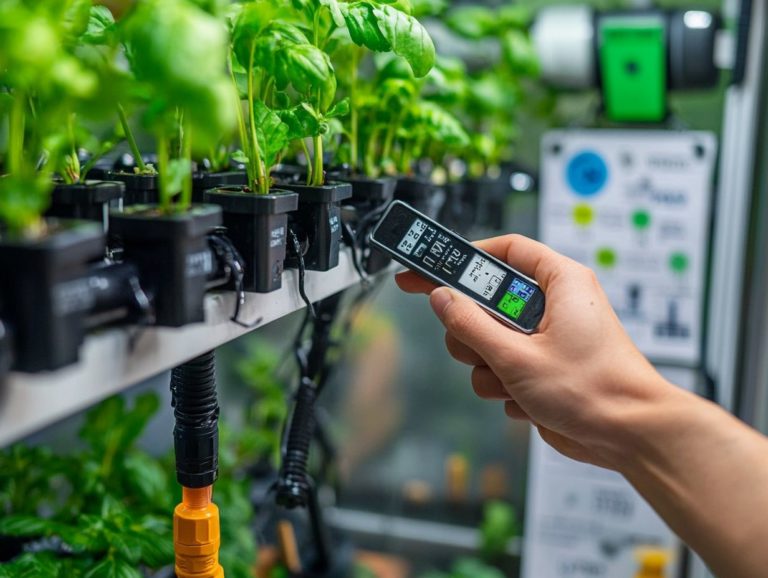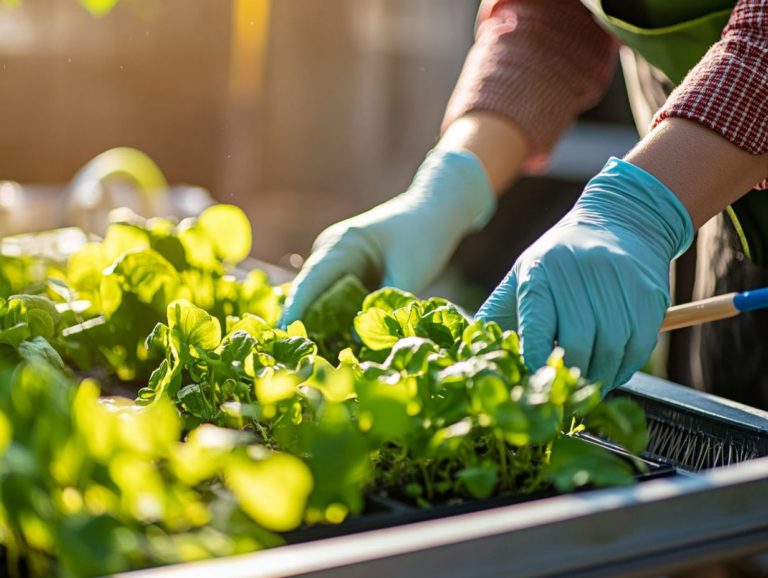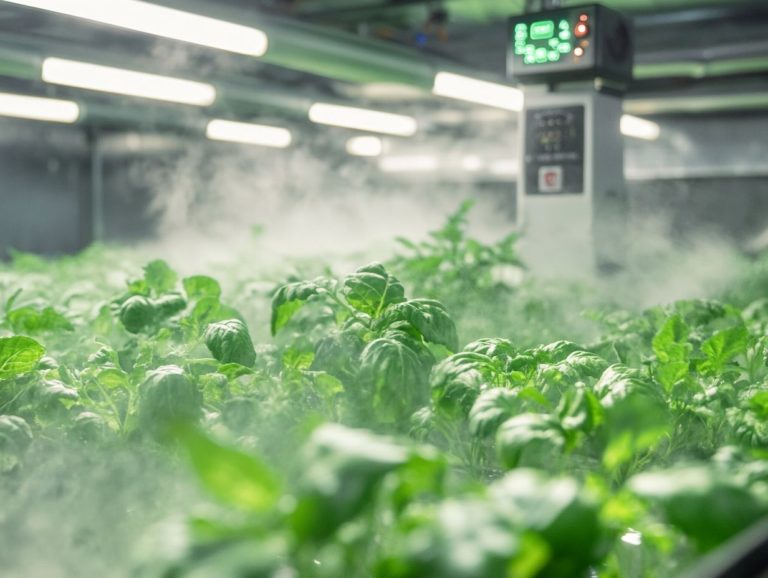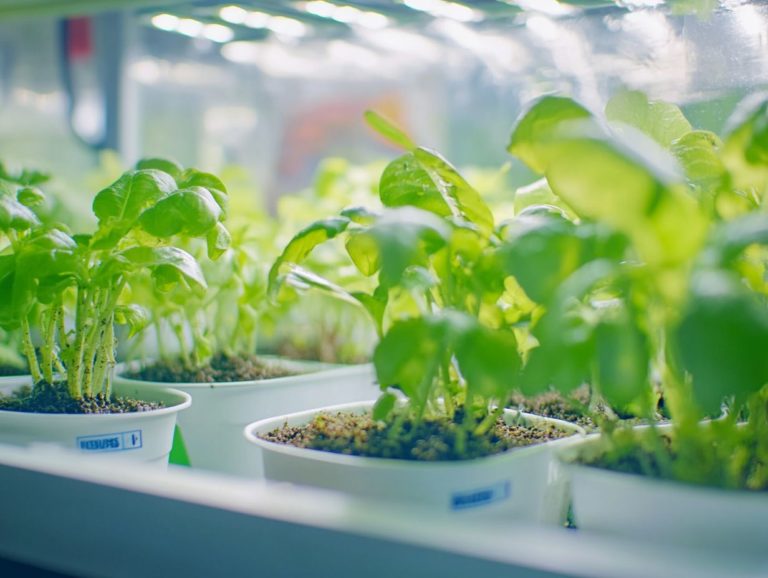Common Hydroponic Diseases and Treatments
Hydroponics presents a groundbreaking approach to cultivating plants, yet it also introduces unique challenges. Hydroponic diseases can jeopardize your crops, leading to diminished yields and wasted resources.
This article delves into prevalent hydroponic diseases, from root rot to nutrient deficiencies, while offering effective treatment strategies. You’ll discover preventive measures and alternative solutions to ensure your system flourishes.
Get ready to protect your hydroponic garden and watch it thrive!
Contents
- Key Takeaways:
- Common Hydroponic Diseases
- Preventive Measures for Hydroponic Diseases
- Treating Hydroponic Diseases
- Alternative Solutions for Hydroponic Disease Prevention
- Frequently Asked Questions
- What are some common hydroponic diseases and treatments?
- How can I prevent damping off in my hydroponic system?
- What is the best way to treat root rot in a hydroponic system?
- Can hydroponic plants get powdery mildew?
- What are signs that my hydroponic plants may have a disease?
- Are there any natural treatments for hydroponic diseases?
Key Takeaways:
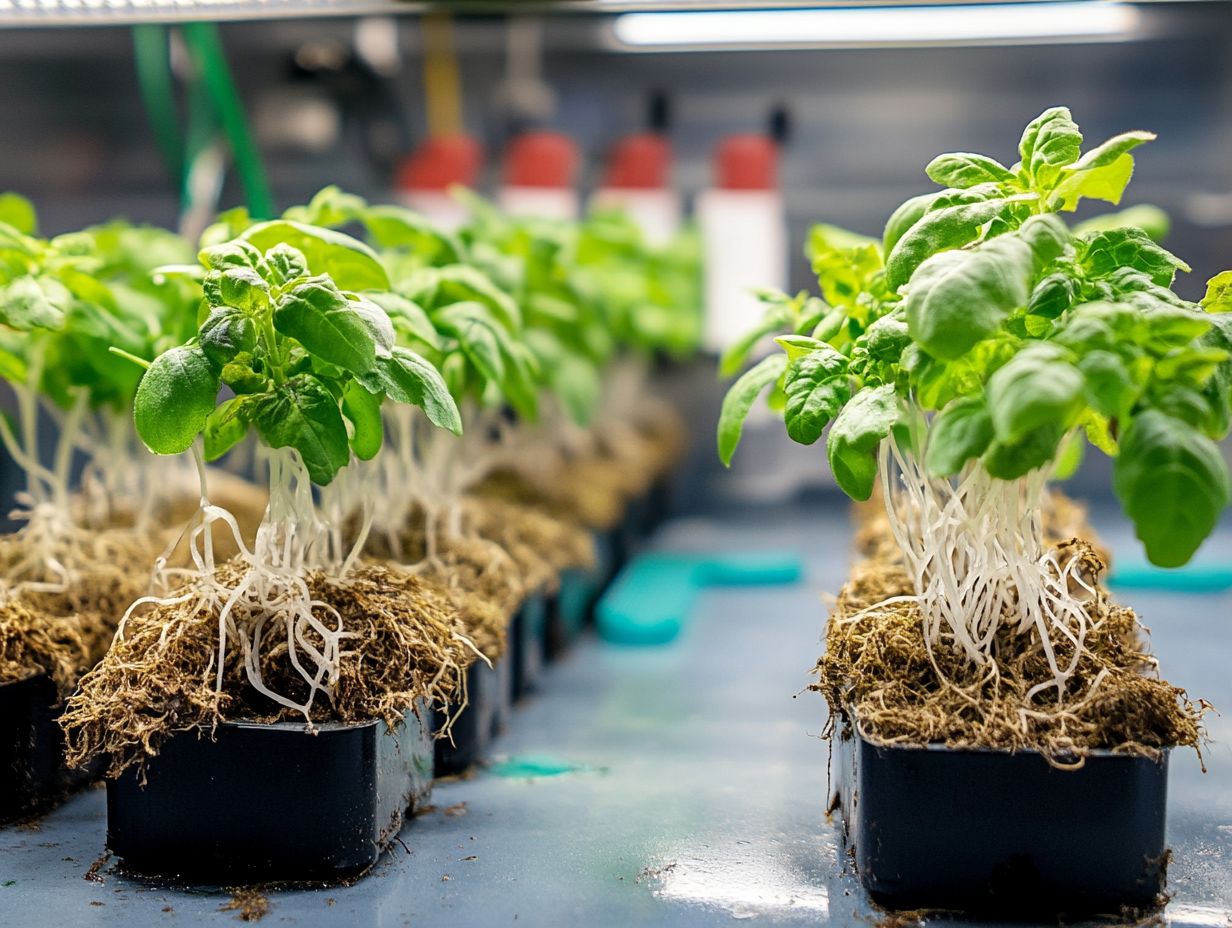
- Properly identifying and treating root rot is essential for maintaining a healthy hydroponic system.
- Regularly checking and managing nutrient levels can help prevent deficiencies and promote plant growth.
- Implementing preventive measures, such as maintaining a clean system and using pest control methods, can help prevent and treat hydroponic diseases.
What are Hydroponic Diseases?
Hydroponic diseases encompass a variety of plant ailments that can arise in your hydroponic gardening systems, where you re growing plants without soil and relying on nutrient solutions and controlled environments for growth. Understanding these diseases is essential for maintaining a flourishing indoor garden.
Various disease-causing organisms and pests can threaten the health and yield of your hydroponic plants, leading to problems like root rot and microbial diseases. This knowledge equips you to implement effective pest control and disease management strategies. Additionally, identifying common hydroponic system issues ensures the resilience and vitality of your hydroponic system.
For instance, fungal pathogens such as Pythium and Fusarium can wreak havoc on roots, causing yellowing leaves and stunted growth, which ultimately diminishes your crop yield. Bacterial infections might present as wilting or soft, mushy roots, making your plants more susceptible to further decline. Recognizing these symptoms early is crucial for developing prevention strategies like maintaining optimal nutrient levels and ensuring proper airflow. Additionally, identifying pest problems in hydroponics can further enhance your plants’ health.
Introducing beneficial microorganisms can help suppress harmful pathogens, fostering a more robust growing environment. By employing these disease management techniques, you can not only protect your plants but also enhance overall productivity in your hydroponic system.
Common Hydroponic Diseases
Common hydroponic diseases such as fungal infections think powdery mildew and downy mildew along with root rot, can wreak havoc on plant health if not managed with care.
It’s crucial to grasp the intricacies of these diseases, including their symptoms and underlying causes, especially if you’re striving to maintain a thriving hydroponic system.
Your success as an indoor gardener hinges on this knowledge, enabling you to cultivate a flourishing environment for your plants.
Identifying and Treating Root Rot
Root rot is a serious condition often brought on by pathogens like Pythium and Fusarium. It results in compromised plant health and potentially catastrophic crop losses in hydroponic gardening. Identifying root rot early is essential; symptoms such as wilting, yellowing leaves, and stunted growth indicate that the root system is in distress and demands immediate attention.
These pathogens flourish in overly saturated soil, so it’s crucial to regularly monitor moisture levels and ensure adequate soil drainage. Once you notice symptoms, you may need to apply fungicides to manage the infection. However, don’t overlook the importance of evaluating your cultural practices that might have contributed to the problem.
Root rot doesn’t just impact individual plants; it can spread, making effective pest control measures vital to protect your surrounding flora. By implementing preventative strategies like crop rotation, proper irrigation techniques, and selecting disease-resistant varieties, you can significantly reduce the risk of recurrence. Additionally, understanding how to troubleshoot common hydroponics issues can help you cultivate healthier plant ecosystems.
Managing Nutrient Deficiencies
Managing nutrient deficiencies is crucial for the health of your hydroponic plants. When nutrient solutions are imbalanced, you may encounter issues like nitrogen, calcium, or magnesium deficiencies. Recognizing the signs of these deficiencies allows you to adjust your nutrient balance and incorporate advanced nutrients to support robust plant growth and overall vitality.
If you notice your plants leaves turning yellow, this could indicate nitrogen deficiency. Calcium deficiency might present as blossom end rot in your fruits. Meanwhile, magnesium deficiency often shows through yellowing between leaf veins, known as interveinal chlorosis.
By closely monitoring these symptoms and understanding their implications, you can develop tailored nutrient solutions that ensure your plants receive the right mix of elements. Leverage advanced nutrients alongside a balanced nutrient strategy for a comprehensive approach to remedying these deficiencies. This creates a thriving hydroponic environment where your plants can flourish and yield abundantly.
Preventing and Treating Fungal Infections
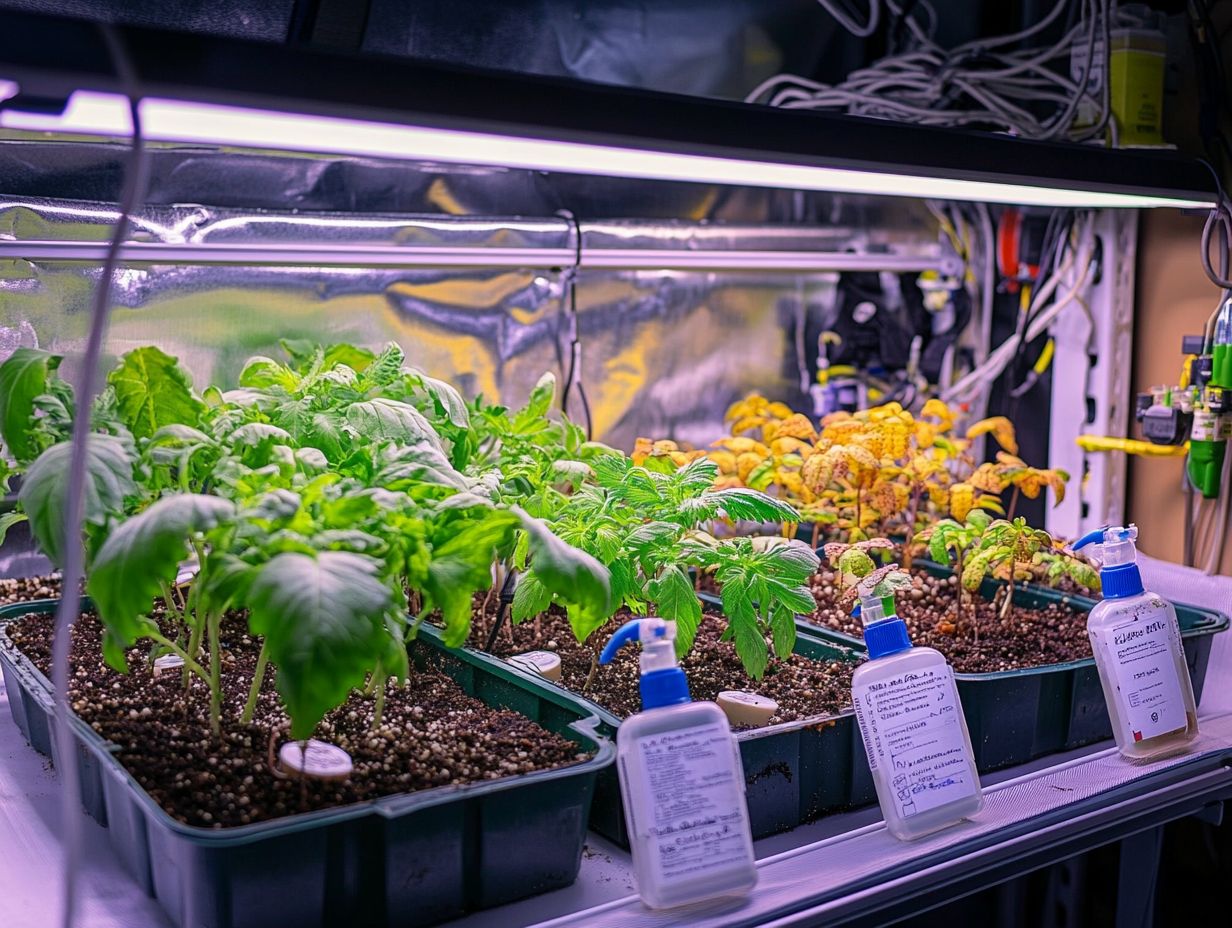
Preventing and treating fungal infections like powdery mildew and downy mildew is essential for safeguarding your hydroponic plants. These diseases can spread rapidly in a grow room, seriously affecting your yield. Employ effective disease management techniques and pest prevention strategies to create a powerful shield around your crops and maintain a pristine environment.
Key conditions that favor fungal growth include high humidity, poor air circulation, and overcrowded plants. To tackle these challenges, maintain optimal humidity levels through proper ventilation and strategically placed fans to significantly reduce outbreak risks.
Integrate organic pesticides such as neem oil or sulfur to treat existing infections while deterring future issues. Implement crop rotation and choose resistant plant varieties to boost disease resilience, ensuring you’re well-equipped to preserve both your plants and your precious yields.
Dealing with Pests and Insects
Dealing with pests and insects like spider mites, aphids, and whiteflies poses a significant challenge in hydroponic gardening. These pests can lead to infestations that jeopardize your indoor garden’s health.
To manage these pests effectively and maintain plant vitality, use a mix of pest control methods. Introduce beneficial predators and utilize organic pesticides.
Understanding pest identification techniques is crucial. Early recognition of an infestation can greatly impact your pest management strategies. Gaining insight into the lifecycle of common pests enables you to craft timely interventions that disrupt their reproduction.
Use techniques like sticky traps to provide visual cues about pest presence, while various sprays offer targeted control options.
By integrating these methods into a comprehensive pest prevention strategy, you can safeguard your crops and ensure a thriving hydroponic ecosystem. Additionally, knowing how to fix common hydroponic plant problems can further enhance your gardening success.
Preventive Measures for Hydroponic Diseases
Implementing preventive measures for hydroponic diseases is essential for maintaining a pristine environment and ensuring your plants thrive. Understanding key strategies for pest control and disease management will help you proactively reduce risks associated with common diseases and pests that threaten hydroponic systems.
Investing time in these strategies will pay dividends in the health and productivity of your garden.
Best Practices for Maintaining a Healthy Hydroponic System
To maintain a thriving hydroponic system, embrace a range of strategies centered on pest prevention, optimal nutrient levels, and cultivating a pristine environment for your plants. By following these best practices, you enhance plant health and yield, paving the way for sustainable success in your indoor gardening endeavors.
Regular system checks are crucial for spotting potential issues before they escalate, allowing you to intervene promptly. Keeping a close eye on nutrient levels and pH levels ensures your plants receive essential elements for vigorous growth. Plus, an effective filtration system helps maintain water purity, vital for your plants well-being.
Implement strict cleanliness standards like regularly disinfecting your equipment and tools to significantly reduce the risk of disease and pest infestations. Additionally, managing root rot in hydroponic plants is crucial for maintaining a healthy environment. These proactive measures foster a well-balanced ecosystem where your crops can flourish, leading to a more productive and rewarding hydroponic experience.
Treating Hydroponic Diseases
Addressing hydroponic diseases demands a comprehensive strategy that integrates effective pest control techniques and disease management practices to rejuvenate plant health and resilience.
Familiarize yourself with the range of treatment options at your disposal to make informed choices when confronted with plant diseases and pests. This ensures your indoor garden thrives.
Effective Treatment Methods
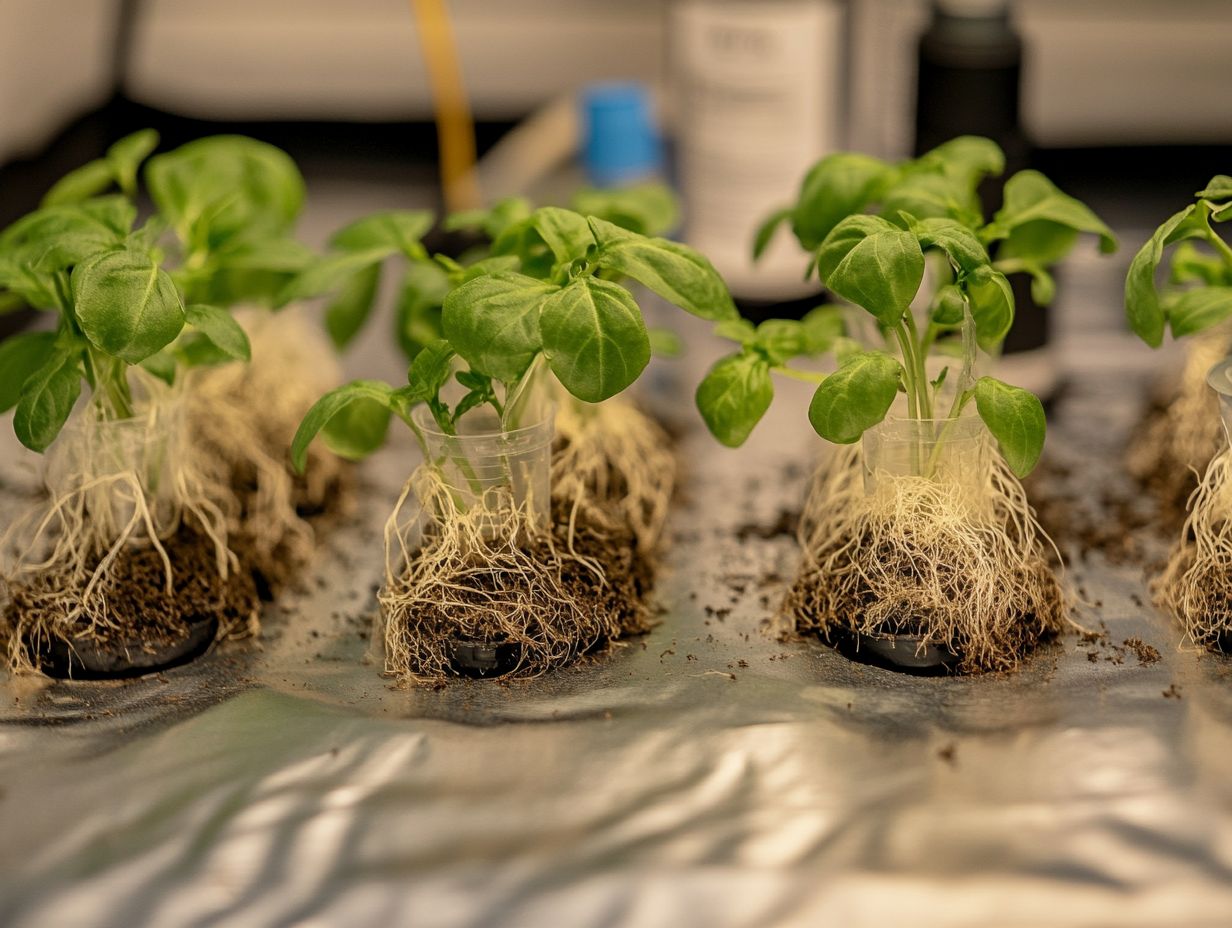
Effective treatment methods for hydroponic diseases often involve combining various disease management techniques, including applying organic pesticides to tackle fungal infections and other pathogens. Tailor your treatments to specific diseases and plant pests to enhance plant health and prevent further infestations.
Among these techniques, Neem Oil stands out for its antifungal properties. Use it to control fungal diseases while also repelling unwanted pests. Incorporate beneficial predators like ladybugs and predatory mites to foster a balanced ecosystem that further boosts disease resistance.
Utilize Integrated Pest Management (IPM) strategies, which combine natural predators and minimal chemicals to effectively reduce reliance on synthetic chemicals. Regular monitoring and maintaining a clean environment are critical for disease prevention, ensuring your crops flourish while minimizing the risk of infections.
Alternative Solutions for Hydroponic Disease Prevention
Exploring alternative solutions for hydroponic disease prevention offers invaluable insights into innovative gardening techniques and gardening tips that elevate plant health and resilience.
Tap into resources available at hydroponics stores for a diverse array of products and expert tips designed to combat common diseases like powdery mildew and downy mildew. You can also learn how to troubleshoot common hydroponic issues to ensure optimal growing conditions.
Exploring Different Growing Techniques and Systems
Exploring various growing techniques and hydroponics systems profoundly influences your plants’ health and streamlines your disease prevention efforts in indoor gardening. Investigate the operation and unique benefits of each system to select the optimal setup tailored to your specific plants and environment.
For example, the nutrient film technique (NFT) offers efficient nutrient delivery, while deep water culture (DWC) allows roots to bask in oxygen. Each hydroponic method boasts advantages, from conserving water to reducing the risk of soil-borne diseases. However, it’s important to consider potential drawbacks, such as initial setup costs and the necessity for constant monitoring. Additionally, understanding identifying and treating hydroponic stress can further enhance your gardening success.
Ultimately, adopting the right hydroponic system accelerates growth rates and cultivates a healthier growing environment, essential for pest control and preventing common plant diseases, ensuring robust development.
Frequently Asked Questions
Ready to take your garden to the next level? Start your hydroponic gardening journey today and explore more resources for tips and tricks!
What are some common hydroponic diseases and treatments?
Common hydroponic diseases include damping off, root rot, and powdery mildew. You can treat these by improving air circulation, maintaining proper nutrient levels, and using organic fungicides.
How can I prevent damping off in my hydroponic system?
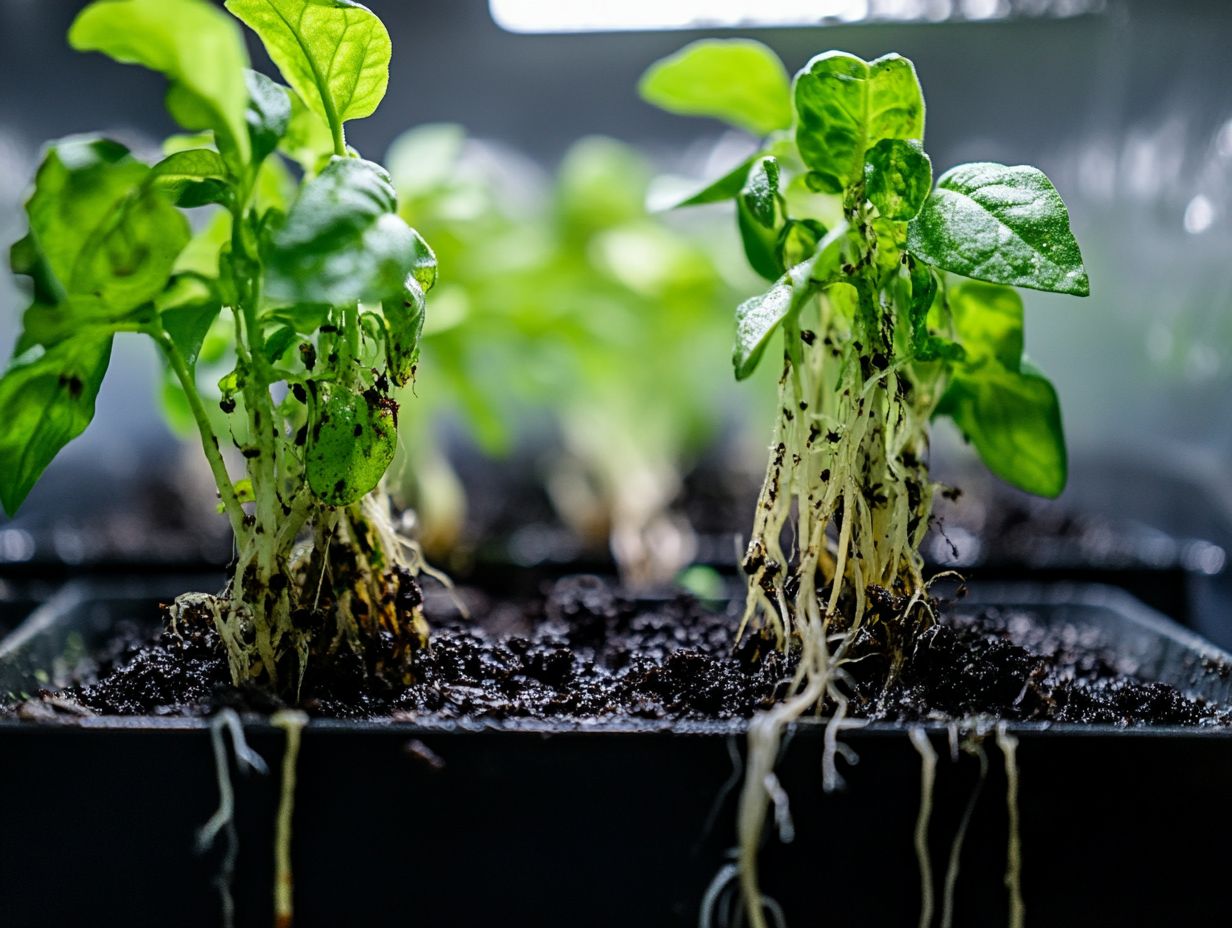
To prevent damping off, ensure good air circulation. Use a beneficial bacteria inoculant to boost your plants immune systems and keep a clean environment.
What is the best way to treat root rot in a hydroponic system?
To treat root rot, remove any affected roots right away. Sanitize the system and use a beneficial bacteria inoculant to maintain proper nutrient levels and prevent future issues.
Can hydroponic plants get powdery mildew?
Absolutely! Hydroponic plants can fall victim to powdery mildew, especially in high humidity with poor air circulation. Regular cleaning and organic fungicides can effectively prevent and treat this problem.
What are signs that my hydroponic plants may have a disease?
Watch for signs like wilting, discoloration, stunted growth, or unusual spots. Monitoring your plants regularly and keeping your system clean can help catch diseases early.
Are there any natural treatments for hydroponic diseases?
Yes, many natural treatments exist for hydroponic diseases. Consider using beneficial bacteria and fungi, neem oil, or essential oils they’re safe and effective alternatives to chemical treatments.

